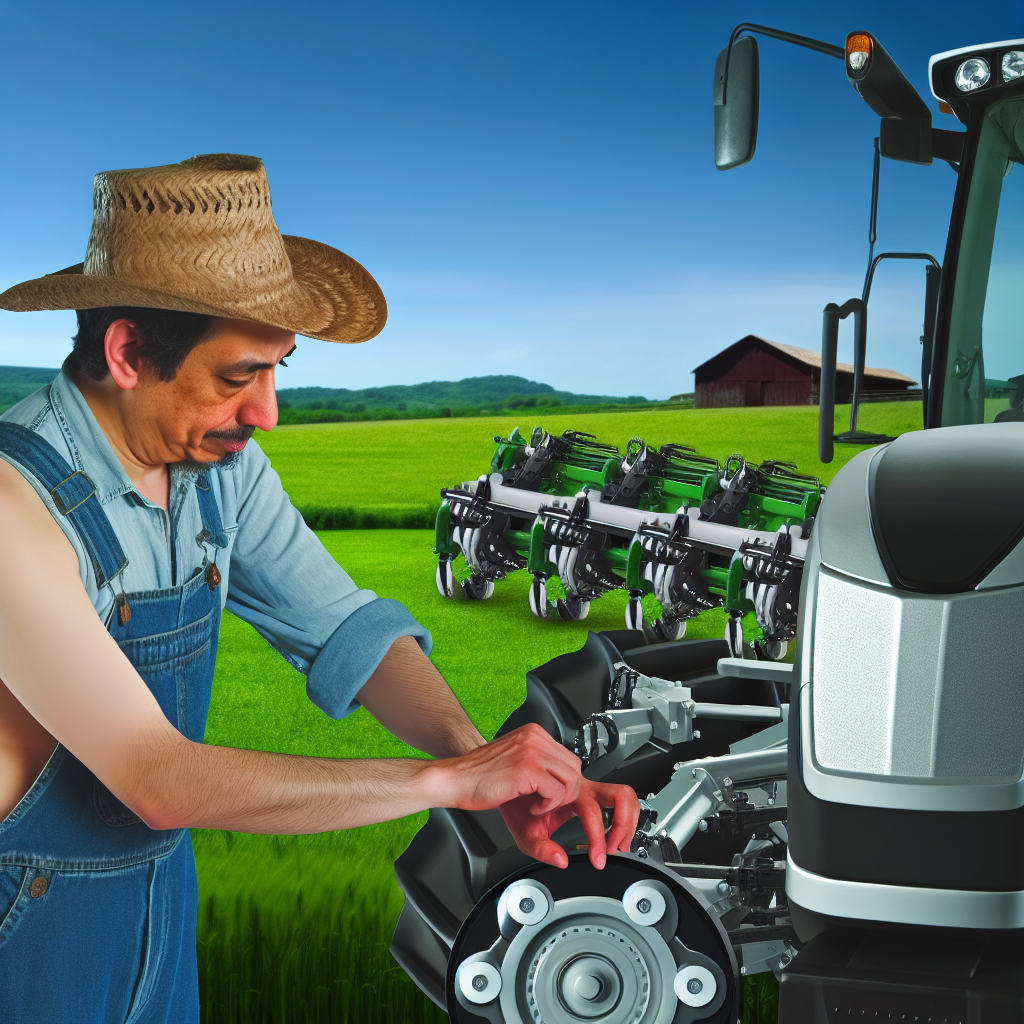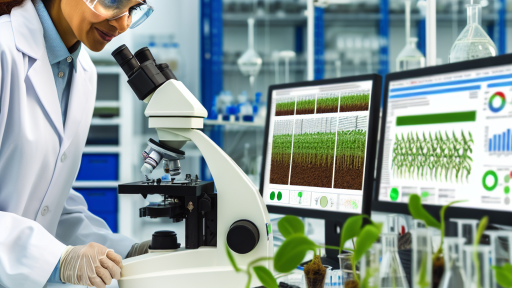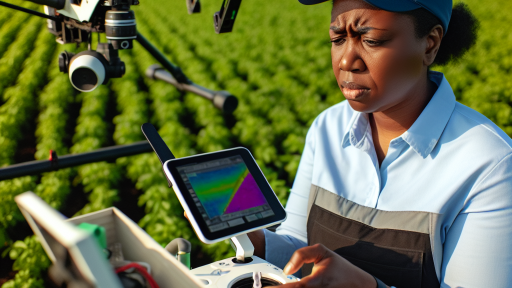Understanding the Benefits of Automated Machinery in Farming
Increased Efficiency
Automated machinery significantly boosts farm efficiency.
With high precision, these machines reduce human error.
Farmers can accomplish more tasks in less time.
This leads to better resource management and savings.
Cost Savings
Investing in automation lowers operational costs over time.
Labor costs decrease as machines take over repetitive tasks.
Agricultural machinery often uses fewer inputs, such as fuel.
Over time, this results in greater profitability for farms.
Consistency and Quality
Automated systems provide consistent results in crops.
This consistency leads to high-quality produce for markets.
Farmers can maintain uniformity with automated harvesting processes.
Ultimately, this enhances the reputation of their products.
Data Collection and Management
Modern machinery facilitates better data collection in the field.
Farmers can monitor crop health and productivity effectively.
This data helps in making informed decisions for future planting.
Transform Your Agribusiness
Unlock your farm's potential with expert advice tailored to your needs. Get actionable steps that drive real results.
Get StartedAccurate data analysis optimizes overall farm management.
Labor Availability
Agricultural automation addresses labor shortages in rural areas.
Many farms struggle to find enough skilled workers.
Machines can take over essential roles without delays.
Consequently, farmers maintain productivity levels year-round.
Enhanced Safety
Automated machinery reduces human involvement in hazardous tasks.
This minimizes the risk of injuries on the farm.
With better safety measures, farms can protect their workers.
Improving the workplace environment leads to higher morale.
Assessing Your Farm’s Specific Needs and Goals
Defining Your Agricultural Objectives
Start by defining clear agricultural objectives for your farm.
Consider what crops or livestock you want to focus on.
Identify the scale of your farming operation.
Additionally, determine whether you aim for expansion or efficiency.
Evaluating Land and Resources
Next, evaluate your land’s characteristics and resources.
Assess soil quality and moisture levels to make informed decisions.
Examine available infrastructure and equipment on your farm.
Consider the accessibility of water and utility connections.
Understanding Labor Availability
Labor availability plays a crucial role in choosing automated machinery.
Identify the skills of your current workforce.
Consider if you require additional training for advanced machinery.
In addition, think about the cost implications of hiring more staff.
Researching Automation Options
Begin researching different types of automated machinery available.
Take note of machinery that aligns with your objectives.
Look for reviews and testimonials from other farmers.
Showcase Your Farming Business
Publish your professional farming services profile on our blog for a one-time fee of $200 and reach a dedicated audience of farmers and agribusiness owners.
Publish Your ProfileMoreover, evaluate the performance of these machines in similar conditions.
Determining Budget Constraints
Lastly, establish a clear budget for your automated machinery.
Consider initial costs as well as long-term maintenance expenses.
Check for government grants or subsidies that might apply.
Ultimately, make sure your investment aligns with your financial goals.
Evaluating Different Types of Automated Machinery Available
Understanding Your Farming Needs
Begin by assessing your specific farming needs.
Consider the crops you grow and their growth cycles.
Next, evaluate the size of your farm and available resources.
Additionally, think about your budget and investment capabilities.
Automation in Planting
Planting automation can significantly improve efficiency.
Seeders and planters are essential pieces of equipment.
They reduce labor costs and increase planting accuracy.
Nowadays, many models offer GPS-guided technology.
This technology ensures optimal seed placement and spacing.
Irrigation Solutions
Automated irrigation systems can save water and time.
Drip irrigation systems deliver water directly to roots.
They optimize water usage, minimizing waste.
Sprinkler systems can also be automated for flexibility.
Look for systems with weather-responsive controls.
Harvesting Equipment
Harvesting machinery has evolved to enhance productivity.
Consider automated harvesters for large-scale operations.
These machines can significantly speed up the harvest process.
Robotic systems are also emerging in this field.
They can selectively harvest crops with precision.
Tilling and Soil Management
Automated tillers simplify soil preparation tasks.
They help ensure consistent soil aeration and mixing.
This process improves crop yields and soil health.
Additionally, some tillers come with integrated sensors.
These sensors monitor soil conditions, enhancing your decision-making.
Maintenance and Support
Consider the availability of support and maintenance services.
Choose machinery from companies with strong customer support.
Ensure they offer warranty options for peace of mind.
Regular maintenance is crucial for optimal machinery performance.
Additionally, access to spare parts should be a priority.
You Might Also Like: Securing Agricultural Supply Chains With Blockchain Technology
Cost Analysis: Budgeting for Automation in Agriculture
Understanding the Costs of Automation
Automated machinery represents a significant investment for farmers.
Understanding the total cost of ownership is crucial.
Consider not just the purchase price, but also ongoing maintenance costs.
Additionally, factor in the costs of training staff to operate machinery.
Moreover, examine the potential need for upgrades in the future.
Showcase Your Farming Business
Publish your professional farming services profile on our blog for a one-time fee of $200 and reach a dedicated audience of farmers and agribusiness owners.
Publish Your ProfileDeveloping a Budget
Creating a budget for agricultural automation requires careful planning.
Start by identifying your specific automation needs.
Next, research various machinery options available on the market.
Compare prices for each type of equipment you’re considering.
Also, factor in any financing options that may be available.
Potential Return on Investment
Evaluate the potential financial benefits of automation.
Automated systems can improve operational efficiency significantly.
They can also increase crop yields and reduce labor costs.
These efficiencies often translate into higher profits for farmers.
Consider case studies where automation has proven beneficial.
Assessing Financial Assistance Programs
Look into government grants and subsidies for automation.
Many programs aim to support farmers in adopting new technologies.
Research local and federal resources available to you.
Connect with agricultural extension officers for guidance.
They can provide valuable information on funding opportunities.
Understanding Risk Management
Budgeting for automation also involves assessing financial risks.
Evaluate how market fluctuations could impact your operations.
Consider potential failures of automated systems and their costs.
Additionally, ensure your budget allows for unexpected expenses.
Proper planning can mitigate risks associated with automation.
Find Out More: Sustainable Farming Practices With GM Crops
Investigating the Technology Behind Automated Farming Equipment
Introduction to Automated Farming Technology
Automated farming technology transforms traditional farming methods.
This evolution enhances efficiency and productivity across farms.
Farmers now utilize sophisticated machinery to reduce labor costs.
Consequently, the demand for advanced farming solutions has surged.
Types of Automated Farming Equipment
Several types of automated equipment assist modern farmers.
- Autonomous tractors navigate fields with minimal human intervention.
- Drone technology monitors crop health from above.
- Robotic harvesters efficiently gather crops, minimizing wastage.
- Precision irrigation systems deliver water accurately to plants.
Benefits of Automation in Farming
Employing automated machinery delivers numerous advantages.
First, it significantly increases operational efficiency.
Additionally, automated systems often enhance crop yields.
Farmers can also access real-time data to make informed decisions.
Moreover, automation reduces the physical burden on farmworkers.
Challenges of Adopting Automated Farming Technology
Despite the benefits, several challenges remain.
Initial costs for advanced machinery can be prohibitive.
Moreover, farmers may face a steep learning curve with new technology.
Data security and management also raise concerns for many.
Consequently, ongoing support and training become essential.
Future Developments in Automated Farming
The future of automated farming looks promising and innovative.
Advancements in artificial intelligence will personalize farming solutions.
Integration with IoT devices will enhance connectivity and efficiency.
Lastly, sustainability will drive the next wave of farming technology.
Showcase Your Farming Business
Publish your professional farming services profile on our blog for a one-time fee of $200 and reach a dedicated audience of farmers and agribusiness owners.
Publish Your ProfileDelve into the Subject: Reducing Supply Chain Fraud Through Blockchain For Farmers
Integrating Automated Machinery with Existing Farm Practices
Assessing Your Current Operations
Start by evaluating your current farming operations.
Identify tasks that consume significant time and labor.
Additionally, consider areas where precision could improve yields.
This assessment will guide your machinery selection process.
Understanding Machinery Compatibility
Check if new machinery integrates smoothly with existing equipment.
Compatibility can prevent costly modifications down the line.
For example, ensure software systems can communicate effectively.
This aspect is crucial for streamlined operations.
Training and Skill Development
Train farm workers on the new machinery.
Proper training maximizes efficiency and safety.
Consider workshops or partnership programs with suppliers.
These resources can provide valuable guidance.
Monitoring and Evaluation
After integrating machinery, monitor performance closely.
Evaluate if productivity increases meet your expectations.
Make adjustments based on feedback and performance data.
This approach allows for continuous improvement in farm practices.
Cost-Benefit Analysis
Conduct a cost-benefit analysis before implementation.
Include not only initial purchase costs but also maintenance expenses.
Additionally, assess potential increases in yield or labor savings.
Such analyses provide clarity on the overall impact of automation.
Adapting Agricultural Plans
Revise your agricultural plans to incorporate new machinery.
Consider how automated processes can enhance crop management.
Furthermore, align mechanization with your sustainability goals.
This synchronization will yield long-term benefits for your farm.
See Related Content: Drone Applications For Pest And Disease Control

Maintenance and Support Considerations for Automated Systems
Importance of Regular Maintenance
Regular maintenance is crucial for optimal performance.
It helps prevent unexpected breakdowns that can disrupt productivity.
Additionally, scheduled maintenance extends the lifespan of your equipment.
Understanding Manufacturer Support
Choosing machinery with strong manufacturer support is essential.
Reliable manufacturers offer comprehensive service options and parts availability.
Support can include on-site maintenance and remote troubleshooting.
Training and Skill Development
Proper training for your staff enhances machinery usage.
Investing in training reduces operational errors significantly.
Moreover, skilled operators can identify issues early on.
Choosing the Right Maintenance Contracts
Evaluate different maintenance contracts before making a decision.
Some contracts may cover all aspects of service, including parts.
Others may focus solely on labor, which could lead to unexpected costs.
Keeping Detailed Maintenance Records
Maintain detailed records of all maintenance activities.
These records help in tracking equipment performance over time.
Showcase Your Farming Business
Publish your professional farming services profile on our blog for a one-time fee of $200 and reach a dedicated audience of farmers and agribusiness owners.
Publish Your ProfileUtilizing software for maintenance management can streamline this process.
Real-World Case Studies: Successful Automation in Farming
Case Study: Green Valley Farms
Green Valley Farms implemented automated irrigation systems in 2021.
The farm reduced water usage by 30% through smart technology.
Farmers can now monitor soil moisture levels remotely.
This innovation increased crop yields by 15% in just one season.
Case Study: Harvest Robotics
Harvest Robotics introduced autonomous harvesters on large fields.
These machines operate round the clock, optimizing harvest time.
By reducing labor costs, the farm saved approximately $200,000 annually.
As a result, they expanded their operational capacity significantly.
Case Study: Sunny Acres Vineyard
Sunny Acres Vineyard adopted drone technology for crop monitoring.
Drones provide real-time aerial imagery of the vineyard.
Farmers quickly identify disease and infestation areas.
This proactive approach has led to a 20% increase in grape quality.
Case Study: West Plains Dairy
West Plains Dairy used robotic milking systems for efficiency.
With automation, milking occurs at any time, easing labor demands.
This method improved milk production by 10% while enhancing cow welfare.
The farm now enjoys a more predictable milking schedule.
Impact of Automation in Farming
Automation technologies dramatically impact farming efficiency.
These real-world examples highlight the potential benefits.
Farmers can reduce costs while boosting productivity.
Investing in automation may lead to transformative changes.
Future Trends in Agricultural Automation and Their Impact
Integration of Advanced Technologies
Agricultural automation is evolving rapidly with new technologies.
Farmers increasingly utilize drones for crop monitoring and spraying.
Robotics streamline planting and harvesting processes in fields.
Additionally, IoT devices collect real-time data for improved decision-making.
Increased Precision in Farming
Precision farming techniques enhance efficiency and reduce waste.
Automated machinery now applies fertilizers and pesticides selectively.
This targeted approach minimizes environmental impact significantly.
Moreover, it maximizes yields and optimizes resource use.
Data-Driven Decision Making
The use of big data in farming is on the rise.
Farmers analyze data to understand crop health and weather patterns.
This analysis leads to smarter, more informed farming choices.
As technology advances, data integration improves operational efficiency.
Labor Shortages and Automation Solutions
Labor shortages pose a challenge in the agricultural sector.
Automated solutions emerge as an effective response to this issue.
Farmers rely on autonomous tractors and robotic harvesters more frequently.
This trend ensures productivity remains stable despite labor challenges.
Sustainability and Environmental Considerations
Future agricultural automation will emphasize sustainability.
Smart farming techniques help in conserving water and reducing emissions.
Ecosystems benefit from reduced pesticide usage thanks to automation.
Showcase Your Farming Business
Publish your professional farming services profile on our blog for a one-time fee of $200 and reach a dedicated audience of farmers and agribusiness owners.
Publish Your ProfileFarmers increasingly adopt green technologies to address climate change.
Collaboration and Education in Technology Adoption
Knowledge-sharing fosters innovation adoption among farmers.
Collaborations with tech companies enhance agricultural practices significantly.
Training programs help farmers understand and operate new machinery.
This focus on education promotes effective use of agricultural automation.
Regulatory and Ethical Considerations
As automation expands, regulatory frameworks adapt to new technologies.
Governments seek to ensure safety standards for automated equipment.
Ethical considerations around data privacy are becoming increasingly important.
Farmers must navigate these regulations while adopting automation technologies.




